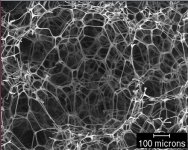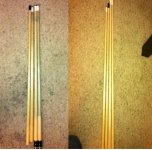After playing (bad) at Hollywood Billiards, I had a shaft full of red stuff. I wanted to wash it off - check out the before and after pics.
Magic Eraser is melamine foam that cleans at the cellular level. The substance gets stuff out while being minimally abrasive. It is roughly the equivalent of 1500 grit paper. It's unique cell structure reaches deep into the pores.
The photos below show why red chalk is a disaster. My playing shaft looked like that after just one day. Contrast that to the blue chalk shaft top and to the right, which had not been cleaned in years. I had already tried to wipe the red off and that didn't work, so here's how I did it.
1) Wet a magic eraser, squeeze out the excess water so it's just damp, and rub the shafts down until they were clean. You can wash out the eraser like a sponge.
2) Let the shafts dry (about 15 minutes). The water will raise the wood grain.
3) Use 1500 to 2000 grit sand paper (dry) to remove the grain.
4) Use a paper shopping bag or parchment paper* to burnish the shafts. Follow with a soft cloth or paper towel.
This is a minimally invasive cleaning technique which will not wear your shafts down while still getting all the grease, oil, chalk and residue off.
Check out the final photo - they are smooth as glass and look like new.
Chris
* Parchment Paper (bakery release paper) is used for baking and is on store shelves near the aluminum foil. It is contains polymer compounds that rub off on the wood and help seal it and make it very smooth.
Was that red chalk made by "blue diamond"? Looks like the shaft in the middle has really worn down, only about 1/4 inch left.

